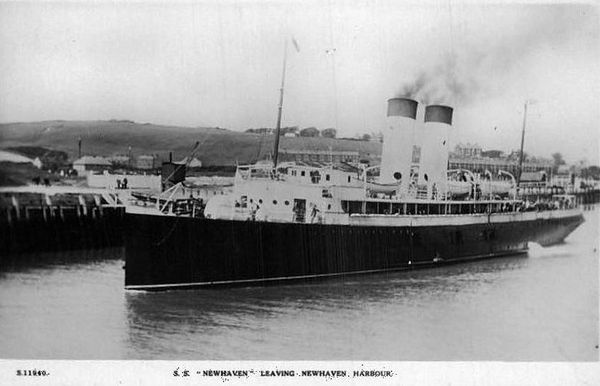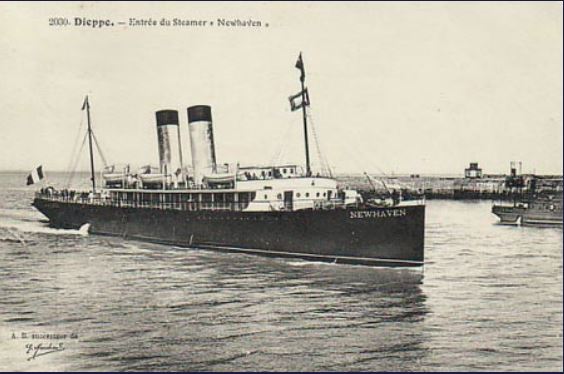Difference between revisions of "HMHS Newhaven"
From Our Contribution
(→France to England 30 September 1917) |
|||
| (3 intermediate revisions by the same user not shown) | |||
| Line 29: | Line 29: | ||
==Remarks== | ==Remarks== | ||
| − | During WW1, she was initially used by the French | + | During WW1, she was initially used by the French as an auxiliary cruiser, but later transferred to the British Flag for use as a Hospital Ship. She carried 3 Medical officers, 4 Nurses and 27 other medical personnel to service up 6 Officer patients, 19 enlisted men in Cots and 138 in Berths. She served in this role from 7 May 1915 until May/June 1917 when the ''Newhaven'' became an Ambulance Transport, (meaning that it as no longer protected by treaty or entitled to the distinctive livery of a red cross on a white background). She could, however, carry troops, serving in this role until 5 Mar 1919. |
| − | Recovered by her owners in July 1919 she was, along with her sister the Rouen, the mainstay of the French side of the Newhaven-Dieppe cross channel service during the 1920's and 30's. In August 1924 the ''Newhaven'' ran aground at night in thick fog under the cliffs at Berneval, about 9 kilometers east of Dieppe. At low tide the next morning, the passengers were able to descend to the beach and board buses to take them into Dieppe. The ship was refloated nine days later, and having suffered minimal damage was quickly back in service. During 1929/30 her interior was upgraded, and two years later she was converted from coal burning to oil fired boilers, and the removal of her two funnels which were replaced with | + | Recovered by her owners in July 1919 she was, along with her sister the ''Rouen'', the mainstay of the French side of the Newhaven-Dieppe cross-channel service during the 1920's and 30's. In August 1924 the ''Newhaven'' ran aground at night in thick fog under the cliffs at Berneval, about 9 kilometers east of Dieppe. At low tide the next morning, the passengers were able to descend to the beach and board buses to take them into Dieppe. The ship was refloated nine days later, and having suffered minimal damage was quickly back in service. During 1929/30 her interior was upgraded, and two years later she was converted from coal burning to oil fired boilers, and the removal of her two funnels which were replaced with one larger one. |
| − | The Newhaven was taken over by the Germans in 1940 and used as a troop transport in the Baltic during World War II. Recovered in 1945, her refitting as a passenger vessel was considered too costly and she was sold for scrap in 1947. | + | The Newhaven was taken over by the Germans in 1940 and used as a troop transport in the Baltic during World War II. Recovered in 1945, her refitting as a passenger vessel was considered too costly and she was sold for scrap in 1947. |
| − | |||
==List of soldiers carried== | ==List of soldiers carried== | ||
| Line 59: | Line 58: | ||
===Calais to England 23 November 1916=== | ===Calais to England 23 November 1916=== | ||
| − | * [[Robert | + | * [[Robert Lauden Rayner]] |
===Calais to England 15 December 1916=== | ===Calais to England 15 December 1916=== | ||
| Line 71: | Line 70: | ||
===France to England 30 September 1917=== | ===France to England 30 September 1917=== | ||
| − | * [Leslie Hetherington]] | + | * [[Leslie Hetherington]] |
===Étaples to England 21 March 1918=== | ===Étaples to England 21 March 1918=== | ||
Latest revision as of 18:30, 4 April 2023
Contents
- 1 Remarks
- 2 List of soldiers carried
- 2.1 Étaples to England 9 Jun 1916
- 2.2 Calais to England 25 July 1916
- 2.3 Boulogne to England 3 August 1916
- 2.4 Calais to England 12 August 1916
- 2.5 Calais to England 20 August 1916
- 2.6 Calais to England 5 November 1916
- 2.7 Calais to England 23 November 1916
- 2.8 Calais to England 15 December 1916
- 2.9 Calais to England 14 May 1917
- 2.10 France to England 27 September 1917
- 2.11 France to England 30 September 1917
- 2.12 Étaples to England 21 March 1918
- 2.13 Étaples to England 26 March 1918
- 2.14 Étaples to England 6 April 1918
- 2.15 Étaples to England 11 April 1918
- 2.16 France to England 25 Aug 1918
Remarks
During WW1, she was initially used by the French as an auxiliary cruiser, but later transferred to the British Flag for use as a Hospital Ship. She carried 3 Medical officers, 4 Nurses and 27 other medical personnel to service up 6 Officer patients, 19 enlisted men in Cots and 138 in Berths. She served in this role from 7 May 1915 until May/June 1917 when the Newhaven became an Ambulance Transport, (meaning that it as no longer protected by treaty or entitled to the distinctive livery of a red cross on a white background). She could, however, carry troops, serving in this role until 5 Mar 1919.
Recovered by her owners in July 1919 she was, along with her sister the Rouen, the mainstay of the French side of the Newhaven-Dieppe cross-channel service during the 1920's and 30's. In August 1924 the Newhaven ran aground at night in thick fog under the cliffs at Berneval, about 9 kilometers east of Dieppe. At low tide the next morning, the passengers were able to descend to the beach and board buses to take them into Dieppe. The ship was refloated nine days later, and having suffered minimal damage was quickly back in service. During 1929/30 her interior was upgraded, and two years later she was converted from coal burning to oil fired boilers, and the removal of her two funnels which were replaced with one larger one.
The Newhaven was taken over by the Germans in 1940 and used as a troop transport in the Baltic during World War II. Recovered in 1945, her refitting as a passenger vessel was considered too costly and she was sold for scrap in 1947.

